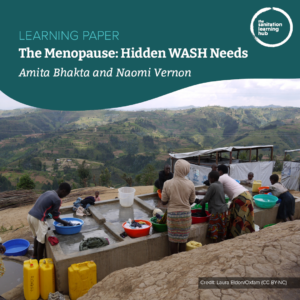
A brand new practical learning paper, The Menopause: Hidden WASH Needs, written by me and Naomi Vernon (Sanitation Learning Hub) has been published by the Sanitation Learning Hub at the Institute of Development Studies.
This new resource provides practical guidance for integrating the needs of (peri) menopausal women into existing WASH programmes, providing recommendations for practitioners and policy makers, and aims to:
- Raise awareness of the perimenopause in the WASH system and the WASH needs of perimenopausal women
- Provide recommendations on how the needs of perimenopausal women can be integrated into existing programmes and tools and guidance for WASH practitioners
The paper gives an overview of what the perimenopause and menopause are, and how the WASH sector can engage with this hidden and taboo topic using feminist and participatory techniques. It uses data from Ghana and the UK to illustrate (peri)menopausal women’s hidden water needs for bathing, laundry and drinking, and sanitation and hygiene needs to support menstrual health and hygiene, and incontinence management.
Practical tips for WASH practitioners to adapt existing programming to integrate the perimenopause are provided, including actions needed for programme start-up and design, and programming activities needed.
The learning paper is available here.
